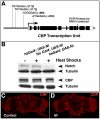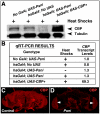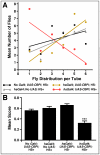Presenilin controls CBP levels in the adult Drosophila central nervous system
- PMID: 21179466
- PMCID: PMC3001863
- DOI: 10.1371/journal.pone.0014332
Presenilin controls CBP levels in the adult Drosophila central nervous system
Abstract
Background: Dominant mutations in both human Presenilin (Psn) genes have been correlated with the formation of amyloid plaques and development of familial early-onset Alzheimer's disease (AD). However, a definitive mechanism whereby plaque formation causes the pathology of familial and sporadic forms of AD has remained elusive. Recent discoveries of several substrates for Psn protease activity have sparked alternative hypotheses for the pathophysiology underlying AD. CBP (CREB-binding protein) is a haplo-insufficient transcriptional co-activator with histone acetly-transferase (HAT) activity that has been proposed to be a downstream target of Psn signaling. Individuals with altered CBP have cognitive deficits that have been linked to several neurological disorders.
Methodology/principal findings: Using a transgenic RNA-interference strategy to selectively silence CBP, Psn, and Notch in adult Drosophila, we provide evidence for the first time that Psn is required for normal CBP levels and for maintaining specific global acetylations at lysine 8 of histone 4 (H4K8ac) in the central nervous system (CNS). In addition, flies conditionally compromised for the adult-expression of CBP display an altered geotaxis behavior that may reflect a neurological defect.
Conclusions/significance: Our data support a model in which Psn regulates CBP levels in the adult fly brain in a manner that is independent of Notch signaling. Although we do not understand the molecular mechanism underlying the association between Psn and CBP, our results underscore the need to learn more about the basic relationship between Psn-regulated substrates and essential functions of the nervous system.
Conflict of interest statement
Figures







Similar articles
-
An Evolutionarily Conserved Role of Presenilin in Neuronal Protection in the Aging Drosophila Brain.Genetics. 2017 Jul;206(3):1479-1493. doi: 10.1534/genetics.116.196881. Epub 2017 May 11. Genetics. 2017. PMID: 28495961 Free PMC article.
-
Drosophila Eye Model to Study Neuroprotective Role of CREB Binding Protein (CBP) in Alzheimer's Disease.PLoS One. 2015 Sep 14;10(9):e0137691. doi: 10.1371/journal.pone.0137691. eCollection 2015. PLoS One. 2015. PMID: 26367392 Free PMC article.
-
Antioxidant proteins TSA and PAG interact synergistically with Presenilin to modulate Notch signaling in Drosophila.Protein Cell. 2011 Jul;2(7):554-63. doi: 10.1007/s13238-011-1073-7. Epub 2011 Aug 6. Protein Cell. 2011. PMID: 21822800 Free PMC article.
-
Presenilins as Drug Targets for Alzheimer's Disease-Recent Insights from Cell Biology and Electrophysiology as Novel Opportunities in Drug Development.Int J Mol Sci. 2018 May 31;19(6):1621. doi: 10.3390/ijms19061621. Int J Mol Sci. 2018. PMID: 29857474 Free PMC article. Review.
-
Familial Presenilin Mutations and Sporadic Alzheimer's Disease Pathology: Is the Assumption of Biochemical Equivalence Justified?J Alzheimers Dis. 2016;50(3):645-58. doi: 10.3233/JAD-150757. J Alzheimers Dis. 2016. PMID: 26757189 Review.
Cited by
-
Epigenetics as a link between environmental factors and dementia risk.J Alzheimers Dis Rep. 2024 Oct 18;8(1):1372-1380. doi: 10.1177/25424823241284227. eCollection 2024. J Alzheimers Dis Rep. 2024. PMID: 40034348 Free PMC article. Review.
-
An Evolutionarily Conserved Role of Presenilin in Neuronal Protection in the Aging Drosophila Brain.Genetics. 2017 Jul;206(3):1479-1493. doi: 10.1534/genetics.116.196881. Epub 2017 May 11. Genetics. 2017. PMID: 28495961 Free PMC article.
-
Conditional deletion of Notch1 and Notch2 genes in excitatory neurons of postnatal forebrain does not cause neurodegeneration or reduction of Notch mRNAs and proteins.J Biol Chem. 2012 Jun 8;287(24):20356-68. doi: 10.1074/jbc.M112.349738. Epub 2012 Apr 13. J Biol Chem. 2012. PMID: 22505716 Free PMC article.
-
Epigenetic disorders: Lessons from the animals-animal models in chromatinopathies.Front Cell Dev Biol. 2022 Sep 26;10:979512. doi: 10.3389/fcell.2022.979512. eCollection 2022. Front Cell Dev Biol. 2022. PMID: 36225316 Free PMC article. Review.
-
Gamma secretase orthologs are required for lysosomal activity and autophagic degradation in Dictyostelium discoideum, independent of PSEN (presenilin) proteolytic function.Autophagy. 2019 Aug;15(8):1407-1418. doi: 10.1080/15548627.2019.1586245. Epub 2019 Mar 21. Autophagy. 2019. PMID: 30806144 Free PMC article.
References
Publication types
MeSH terms
Substances
Grants and funding
LinkOut - more resources
Full Text Sources
Medical
Molecular Biology Databases

